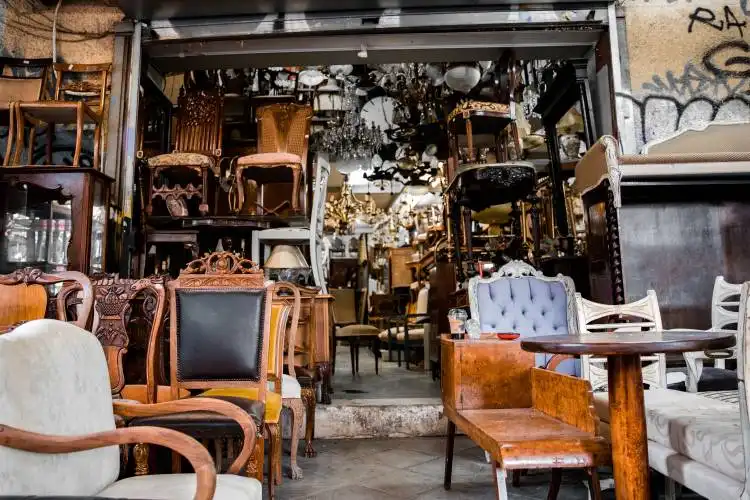Start a Skate Shop
Harness the Thrill: Transforming Passion for Skateboarding into a Successful Business Venture
| Updated


SKATE SHOP
Buckle up for a thrilling ride into the world of entrepreneurship with a Skate Shop! Like a gushing adrenaline rush that propels skaters down the ramps, this business essentially involves selling skateboards, skateboard parts, and related apparel. As you shatter the conventions, be ready to be the hub for all things cool - from hosting skateboarding events to spreading skate culture in your community. Be sure to really 'kickflip' into your customer's needs to drive your business' success.
Jump to Business Plan
RELATED BUSINESS IDEAS
Browse ALL Retail & Shopping Business Ideas
Discover Your Perfect Domain
Unlock the door to your online success with our hand-picked selection of premium domain names. Whether you're starting a new venture or rebranding an existing one, the right domain can set the tone for your digital presence. Browse through our curated list, each with its unique potential to enhance your brand's visibility and credibility.
SKATE SHOP MINI BUSINESS PLAN
This a quick reality check to help you identify the strengths and weaknesses of your business concept before you dive in.
Skate Shop Quick Facts Analysis
Expected Percent Margin:
- Gross Margin: 30-50%
- Net Profit Margin: 5-15%
Earnings Expectations:
- Daily Earnings: $100 - $350
- Weekly Earnings: $700 - $2,450
- Monthly Earnings: $3,000 - $10,500
- Annual Earnings: $36,000 - $126,000
Actions to hit those numbers:
1. Inventory Management:
- Initial Inventory Investment: Plan for starting inventory costs around $10,000 to $30,000.
- Supplier Relationship: Create and maintain a network of reliable and affordable skateboarding gear and clothing suppliers.
2. Marketing and Customer Acquisition:
- Social Media Engagement: Regular engagement on platforms young skaters use, such as Instagram and YouTube. Consider collaborations or sponsorships with local skaters.
- Local Partnerships: Form partnerships with local skating parks and events for increased visibility.
3. Sales and Customer Experience:
- Staff Knowledge: Staff should be knowledgeable about skateboarding culture, gear, and can assist novice skaters with beginner-friendly recommendations.
- Loyalty Program: Develop a strong customer loyalty program to encourage repeat purchases and referrals.
4. Cost Control:
- Lease Costs: Try to keep rent around 5% - 10% of projected sales.
- Utilities & Maintenance: Budget for monthly costs such as water, electricity, internet, waste disposal, and equipment maintenance.
5. Business Operations:
- Store Hours: Consider your target demographic and set store hours accordingly. Late afternoons, evenings, and weekends might be the busiest times.
- Transaction Volume: Aiming for a daily target of around 10-15 transactions at an average price of $30 - $50 per transaction, depending on your product and pricing strategies.
Remember that these numbers are general estimations and can vary greatly depending on numerous factors including location, competence in managing business operations, marketing efforts, and more.
NOT WHAT YOU HAD IN MIND? Here are more ideas



Browse ALL Retail & Shopping Business Ideas
Grab Your Business Website Name
Before you get caught up in the whirlwind of setting up your business, invest in a domain name. It's a small but significant step that lays the foundation for your brand and makes it easier for customers to find and trust you. Just like you wouldn't build a house without securing the land first, don't build a business without securing your domain name.
"Why? Can't that wait?" Here's why it shouldn't
Step 1: Determining if Starting a Skate Shop is Right for You
Breakdown of Startup Expenses
Before starting a skate shop, it is important to understand the startup costs associated with the business. This includes the cost of the physical space, inventory, equipment, and any other necessary supplies. Additionally, it is important to consider the cost of any licenses or permits that may be required to operate the business. It is also important to consider the cost of any marketing or advertising that may be necessary to get the business off the ground. Finally, it is important to consider the cost of any legal or financial services that may be necessary to get the business up and running.
Breakdown of Ongoing Expenses
In addition to the startup costs, it is important to understand the ongoing expenses associated with running a skate shop. This includes the cost of rent, utilities, inventory, and any other necessary supplies. Additionally, it is important to consider the cost of any licenses or permits that may be required to keep the business running. It is also important to consider the cost of any marketing or advertising that may be necessary to keep the business running. Finally, it is important to consider the cost of any legal or financial services that may be necessary to keep the business running.
Examples of Ways to Make Money
There are several ways to make money with a skate shop. One way is to sell skateboards, skateboard accessories, and other related items. Additionally, it is possible to make money by offering skateboard lessons or workshops. It is also possible to make money by hosting skateboard competitions or events. Finally, it is possible to make money by offering skateboard repair services or by selling skateboard apparel.
Step 2: Naming the Business
When naming a skate shop, it is important to choose a name that is memorable and that accurately reflects the type of business. It should be catchy and easy to remember, but also unique and creative. Consider using a combination of words that are related to skateboarding, such as “skate”, “board”, “shop”, and “gear”. Additionally, consider using a play on words or a pun to make the name stand out. For example, a skate shop named “Boardroom” or “Skateland” could be memorable and eye-catching.
When deciding on a name, it is important to consider the potential for trademark infringement. Do some research to make sure that the name is not already in use by another business. Additionally, it is important to check if the name is available as a domain name and as a social media handle. If the name is already taken, consider adding a unique word or phrase to the end of the name to make it unique.
Finally, it is important to consider the potential for growth when choosing a name. A name that is too specific to the skateboarding industry may not be suitable for a business that plans to expand in the future. Consider choosing a name that is more general, such as “Sports Gear” or “Activewear”, so that the business can expand into other areas if desired.
Step 3: Securing Financing
When starting a business, it is important to have the necessary funds to get it up and running. There are a few options for financing a skate shop. The first option is to use personal savings. This is a great option if you have the financial means to do so. Another option is to take out a business loan. This is a great option if you need a larger sum of money to get the business started. You can also look into grants and other forms of financing that are available to small business owners. Finally, you can look into crowdfunding platforms to get the funds you need to get the business started.
Tips for Securing Financing
When it comes to securing financing for your skate shop, it is important to do your research and find the best option for you. Make sure to read the fine print and understand the terms of the loan or grant you are applying for. It is also important to have a solid business plan in place that outlines your goals and objectives. This will help you to secure the funds you need to get the business started. Additionally, it is important to have a good credit score, as this will help you to secure the financing you need. Finally, make sure to shop around and compare different financing options to find the best one for your business.
Step 4: Finding a Location
When choosing a location for a skate shop, there are several factors to consider. First, the location should be in an area that is easily accessible to customers. This could be a busy street corner, a shopping mall, or a popular skate park. Second, the location should be large enough to accommodate the shop’s inventory, as well as any other equipment or services the shop may offer. Third, the rent should be affordable and within the shop’s budget. Finally, the shop should be in a safe area with minimal crime.
Securing a Lease
Once the ideal location has been identified, the next step is to secure a lease. This should include researching the landlord’s requirements, such as the length of the lease and the amount of the security deposit. It is also important to read the lease carefully and make sure that all of the shop’s needs are met. Additionally, the shop should be sure to check the zoning laws in the area to make sure that the shop is allowed to operate in the chosen location.
Obtaining Permits and Licenses
The next step is to obtain the necessary permits and licenses to operate the shop. This will vary depending on the location, but generally includes a business license, a sales tax permit, and any other permits or licenses required by the local government. Additionally, the shop may need to obtain a certificate of occupancy from the local fire department.
Finalizing the Lease
Once all of the permits and licenses have been obtained, the next step is to finalize the lease. This includes signing the lease agreement and paying the security deposit. Additionally, the shop should make sure that all of the necessary insurance policies are in place, such as property, liability, and workers’ compensation insurance. Finally, the shop should make sure that all of the necessary utilities are connected, such as electricity, water, and internet.
Step 5: Obtaining Licenses and Permits
When starting a skate shop, there are several licenses and permits that must be obtained. Depending on the state or country, there may be different requirements. Generally, a business license, a seller’s permit, and a zoning permit are needed. A business license is required to legally operate a business and it is typically issued by the state or local government. A seller’s permit is needed to collect sales tax from customers. A zoning permit is needed to make sure the business is operating in an area that is zoned for commercial use.
How to Obtain Licenses and Permits
The process of obtaining the necessary licenses and permits can be done online or in person. Depending on the state or country, the process may vary. Generally, the business owner will need to fill out an application, submit the necessary documents, and pay the required fees. It is important to research the specific requirements for the state or country in order to ensure all the necessary licenses and permits are obtained.
Cost of Licenses and Permits
The cost of the licenses and permits can vary depending on the state or country. Generally, the cost of a business license can range from $50 to $500. The cost of a seller’s permit can range from $20 to $50. The cost of a zoning permit can range from $50 to $500. It is important to research the specific cost for the state or country in order to budget accordingly.
Time Frame for Obtaining Licenses and Permits
The time frame for obtaining the necessary licenses and permits can vary depending on the state or country. Generally, the process can take anywhere from a few days to a few weeks. It is important to research the specific time frame for the state or country in order to plan accordingly.
Step 6: Purchasing Equipment
When starting a skate shop, there are several types of equipment that will be needed. This includes skateboards, trucks, wheels, bearings, grip tape, and any other accessories that may be desired. It is important to research the different types of equipment available and determine which ones are best for the shop. Additionally, it is important to purchase the equipment from a reliable source to ensure quality.
Cost of Equipment
The cost of the equipment will vary depending on the type and quality of the items purchased. It is important to research the different brands and prices to ensure that the shop is getting the best deal. Additionally, it is important to factor in the cost of shipping and any taxes that may be applicable.
Sourcing Equipment
When sourcing the equipment, it is important to consider the reputation of the supplier. It is important to find a supplier that is reliable and trustworthy. Additionally, it is important to consider the delivery time of the items and the return policy of the supplier.
Stocking the Shop
Once the equipment is purchased, it is important to stock the shop with the items. This includes arranging the items in an attractive manner, displaying them in a way that is easy for customers to find, and pricing the items appropriately. Additionally, it is important to ensure that the shop is stocked with enough items to meet customer demand.
Step 7: Creating a Business Plan
Creating a business plan is an essential step in starting a skate shop. A business plan is a document that outlines the financial, operational, and marketing goals of the business. It should include an executive summary, a description of the business, a market analysis, an organizational plan, a financial plan, and a risk assessment.
The executive summary should provide a brief overview of the business and its goals. It should include the mission statement, the target market, the competitive advantages, and the financial goals of the business.
The description of the business should include the type of business, the location, the products and services offered, and the ownership structure. It should also include the legal structure of the business, such as whether it is a sole proprietorship, partnership, or corporation.
The market analysis should include an analysis of the target market, the competitors, and the industry trends. It should also include a SWOT analysis, which is an analysis of the Strengths, Weaknesses, Opportunities, and Threats of the business.
The organizational plan should include the management structure, the roles and responsibilities of each team member, and the organizational culture. It should also include the organizational structure, such as whether it is a centralized or decentralized organization.
The financial plan should include a budget, a cash flow statement, and a break-even analysis. It should also include a financial forecast, which is a projection of the future financial performance of the business.
The risk assessment should include an analysis of the potential risks that the business may face, such as economic downturns, changes in the market, or changes in the competitive landscape. It should also include a plan for mitigating these risks.
Step 8: Promoting the Business
Promoting the business is key to success. There are many ways to promote a skate shop, such as advertising in local newspapers, magazines, and radio stations. Additionally, creating a website and social media accounts can help spread the word about the business. Additionally, creating a mailing list and sending out flyers to local skate parks and skate shops can help get the word out. Finally, creating a loyalty program and offering discounts can help attract customers.
Tips for Promoting the Business
When promoting the business, it is important to be creative and think outside the box. For example, creating a unique logo and slogan can help the business stand out from the competition. Additionally, creating a blog or podcast can help spread the word about the business. Additionally, creating a referral program and offering discounts to customers who refer friends can help increase sales. Finally, creating a rewards program and offering discounts for customers who purchase multiple items can help encourage customers to come back and shop again.
Step 9: Opening the Business
Opening a business can be a daunting task, but it is important to remain organized and focused. First, it is important to research local laws and regulations related to opening a business. This includes obtaining the necessary permits and licenses. Additionally, it is important to create a business plan that outlines the goals of the business, the target market, and the strategies for achieving success. It is also important to create a budget that outlines the necessary startup and ongoing expenses. Finally, it is important to create a marketing plan that outlines the strategies for reaching the target market.
Setting Up Shop
Once the necessary permits and licenses have been obtained, it is time to set up shop. This includes finding the right location, purchasing the necessary equipment, and stocking the shelves with the right products. It is important to research the local market to determine the best location for the shop. Additionally, it is important to research the best suppliers for the necessary equipment and products. Finally, it is important to create an attractive storefront that will draw customers in.
Launching the Business
Once the shop is set up, it is time to launch the business. This includes creating a website and social media accounts, advertising the business, and hosting grand opening events. Additionally, it is important to create a customer loyalty program to encourage repeat customers. Finally, it is important to create a customer service policy that outlines the expectations for customer service.
EXPLORE MORE CATEGORIES
Browse ALL Business Idea Categories
TAKE THE NEXT STEPS










